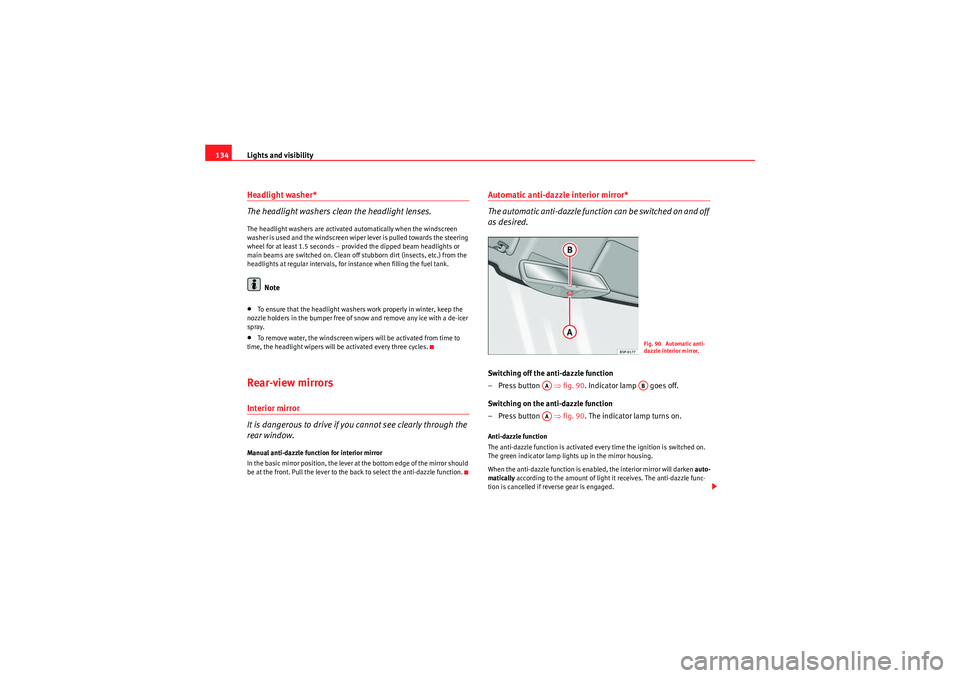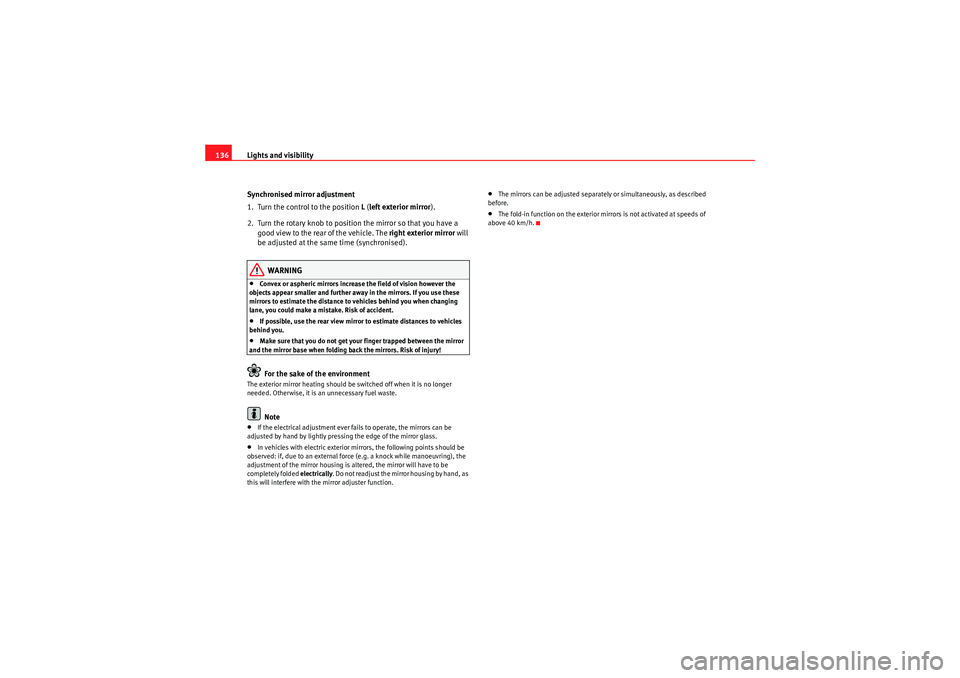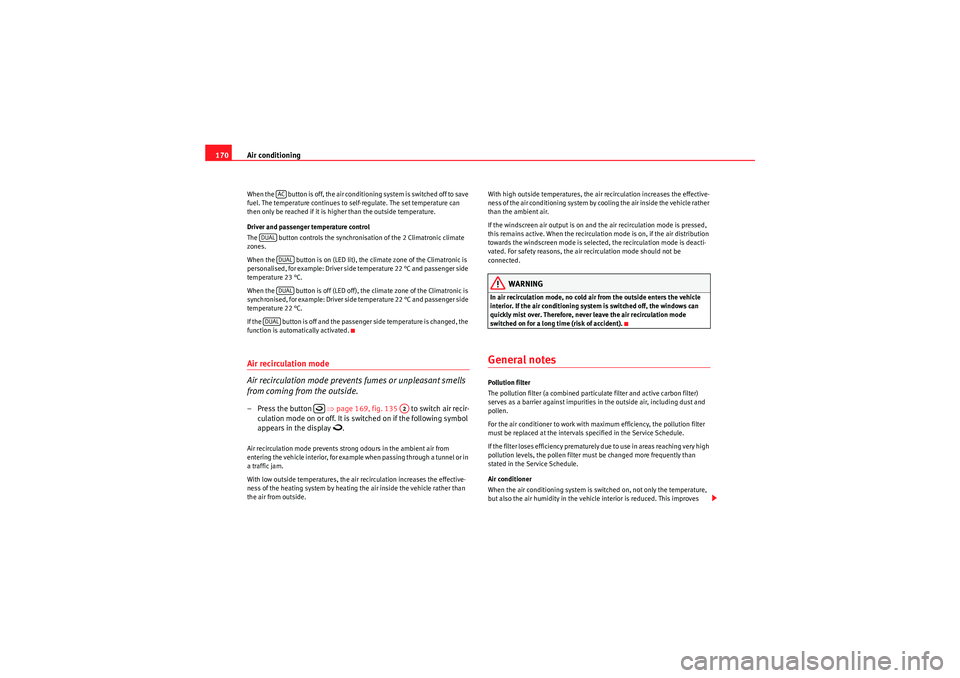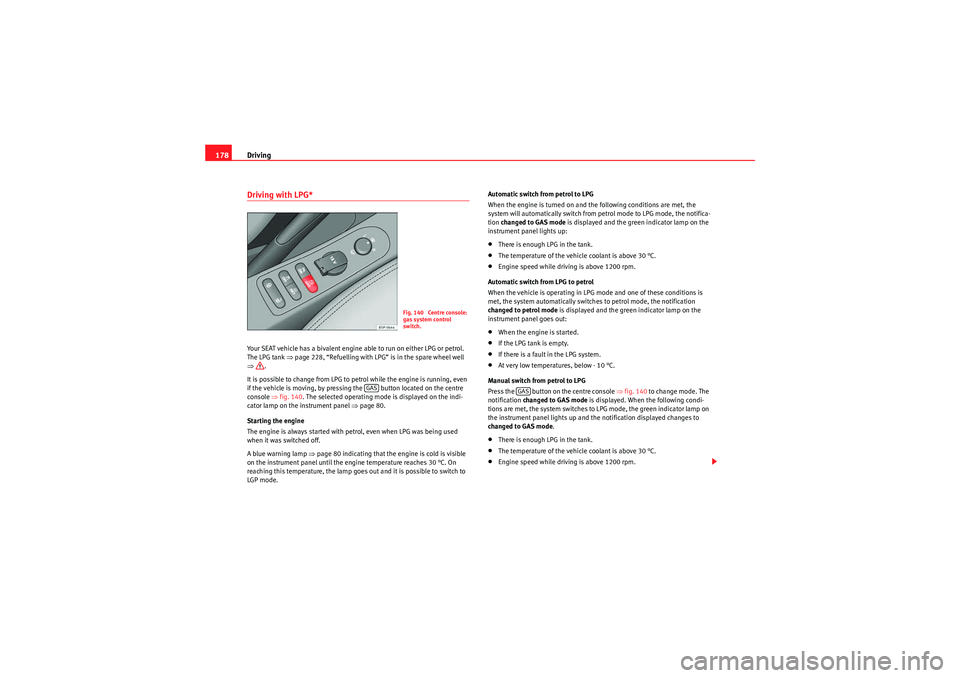2011 Seat Altea XL fuel
[x] Cancel search: fuelPage 89 of 319

Cockpit87
Safety First
Operating Instructions
Practical Tips
Technical Specifications
If you drive faster than 6 km/h with the handbrake on, the following message
will appear on the instrument panel display
17):
HANDBRAKE ON. Yo u w i l l a l s o
hear an acoustic warning signal.
•the brake fluid level is too low ⇒page 245.
The instrument panel displays the following message
17): STOP BRAKE FLUID
INSTRUCTION MANUAL .
•there is a fault in the brake system.
The instrument panel displays the following message
17): BRAKE SYSTEM
FAULT INSTRUCTION MANUAL .
This warning lamp can light up together with the ABS system warning lamp.
WARNING
•Before opening the bonnet, read and observe the warnings on
⇒ page 233.•If the brake warning lamp does not go out, or if it lights up when
driving, the brake fluid level ⇒page 245, “Brake fluid” in the reservoir is
too low. Risk of accident. Stop the vehicle and do not drive on. Obtain tech-
nical assistance.•If the brake warning lamp
�H lights up together with the ABS warning
lamp
�J, the control function of the ABS could be out of action. This could
cause the rear wheels to lock quickly when you brake. This could cause the
rear to break away. Risk of skidding. Stop the vehicle and seek technical
assistance.
Engine oil pressure
�E
If this warning lamp is red it indicates that the engine oil pres-
sure is too low.If this warning symbol starts to flash, and is accompanied by three audible
warnings , switch off the engine and check the oil level. If necessary, add more
oil ⇒page 236.
The instrument panel displays the following message
18): STOP ENGINE OIL
PRESSURE INSTRUCTION MANUAL .
If the symbol flashes although the oil level is correct, do not drive on. The
engine must not even run at idle speed. Obtain technical assistance.
Checking the oil level
�E
If the warning lamp is yellow
�E the engine oil level should be checked as
soon as possible. Top up the oil ⇒page 238 at the next opportunity.
Oil level sensor faulty*
�E
If the
�E yellow warning lamp flashes, take the vehicle to a specialised work-
shop to have the oil level sensor checked. Until then it is advisable to check
the oil level every time you refuel.
Cruise control system*
The warning lamp comes on when the cruise control system
is switched on.The warning lamp
lights up when the cruise control system is switched on.
For further information on the cruise control system, see ⇒page 193.
17)Depending on the model version.
18)Depending on the model version.
AlteaXL_EN.book Seite 87 Donnerstag, 9. September 2010 12:13 12
Page 136 of 319

Lights and visibility
134Headlight washer*
The headlight washers clean the headlight lenses.The headlight washers are activated automatically when the windscreen
washer is used and the windscreen wiper lever is pulled towards the steering
wheel for at least 1.5 seconds – provided the dipped beam headlights or
main beams are switched on. Clean off stubborn dirt (insects, etc.) from the
headlights at regular intervals, for instance when filling the fuel tank.
Note
•To ensure that the headlight washers work properly in winter, keep the
nozzle holders in the bumper free of snow and remove any ice with a de-icer
spray.•To remove water, the windscreen wipers will be activated from time to
time, the headlight wipers will be activated every three cycles.Rear-view mirrorsInterior mirror
It is dangerous to drive if yo u cannot see clearly through the
rear window.Manual anti-dazzle function for interior mirror
In the basic mirror position, the lever at the bottom edge of the mirror should
be at the front. Pull the lever to the back to select the anti-dazzle function.
Automatic anti-dazzle interior mirror*
The automatic anti-dazzle function can be switched on and off
as desired.Switching off the anti-dazzle function
–Press button ⇒ fig. 90. Indicator lamp goes off.
Switching on the anti-dazzle function
–Press button ⇒ fig. 90. The indicator lamp turns on.Anti-dazzle function
The anti-dazzle function is activated every time the ignition is switched on.
The green indicator lamp lights up in the mirror housing.
When the anti-dazzle function is enabled, the interior mirror will darken auto-
matically according to the amount of light it receives. The anti-dazzle func-
tion is cancelled if reverse gear is engaged.
Fig. 90 Automatic anti-
dazzle interior mirror.
AA
AB
AA
AlteaXL_EN.book Seite 134 Donnerstag, 9. September 2010 12:13 12
Page 138 of 319

Lights and visibility
136
Synchronised mirror adjustment
1. Turn the control to the position L ( left exterior mirror ).
2. Turn the rotary knob to position the mirror so that you have a good view to the rear of the vehicle. The right exterior mirror will
be adjusted at the same time (synchronised).
WARNING
•Convex or aspheric mirrors increase the field of vision however the
objects appear smaller and further away in the mirrors. If you use these
mirrors to estimate the distance to vehicles behind you when changing
lane, you could make a mistake. Risk of accident.•If possible, use the rear view mirror to estimate distances to vehicles
behind you.•Make sure that you do not get your finger trapped between the mirror
and the mirror base when folding back the mirrors. Risk of injury!For the sake of the environment
The exterior mirror heating should be switched off when it is no longer
needed. Otherwise, it is an unnecessary fuel waste.
Note
•If the electrical adjustment ever fails to operate, the mirrors can be
adjusted by hand by lightly pressing the edge of the mirror glass.•In vehicles with electric exterior mirrors, the following points should be
observed: if, due to an external force (e.g. a knock while manoeuvring), the
adjustment of the mirror housing is altered, the mirror will have to be
completely folded electrically . Do not readjust the mirror housing by hand, as
this will interfere with the mirror adjuster function.
•The mirrors can be adjusted separately or simultaneously, as described
before.•The fold-in function on the exterior mirrors is not activated at speeds of
above 40 km/h.
AlteaXL_EN.book Seite 136 Donnerstag, 9. September 2010 12:13 12
Page 172 of 319

Air conditioning
170W h en t he but to n is of f, th e a ir co nd it io n ing s yste m is switch ed of f to sav e
fuel. The temperature continues to self-regulate. The set temperature can
then only be reached if it is higher than the outside temperature.
Driver and passenger temperature control
The button controls the synchronisation of the 2 Climatronic climate
zones.
When the button is on (LED lit), the climate zone of the Climatronic is
personalised, for example: Driver side temperature 22 °C and passenger side
temperature 23 °C.
When the button is off (LED off), the climate zone of the Climatronic is
synchronised, for example: Driver side temperature 22 °C and passenger side
temperature 22 °C.
If the button is off and the passenger side temperature is changed, the
function is automatically activated.Air recirculation mode
Air recirculation mode prevents fumes or unpleasant smells
from coming from the outside.–Press the button ⇒page 169, fig. 135 to switch air recir-
culation mode on or off. It is switched on if the following symbol
appears in the display
.
Air recirculation mode prevents strong odours in the ambient air from
entering the vehicle interior, for example when passing through a tunnel or in
a traffic jam.
With low outside temperatures, the air recirculation increases the effective-
ness of the heating system by heating the air inside the vehicle rather than
the air from outside. With high outside temperatures, the air recirculation increases the effective-
ness of the air conditioning system by cooling the air inside the vehicle rather
than the ambient air.
If the windscreen air output is on and the air recirculation mode is pressed,
this remains active. When the recirculation mode is on, if the air distribution
towards the windscreen mode is selected, the recirculation mode is deacti-
vated. For safety reasons, the air recirculation mode should not be
connected.
WARNING
In air recirculation mode, no cold air from the outside enters the vehicle
interior. If the air conditioning system is switched off, the windows can
quickly mist over. Therefore, never leave the air recirculation mode
switched on for a long time (risk of accident).General notesPollution filter
The pollution filter (a combined particulate filter and active carbon filter)
serves as a barrier against impurities in the outside air, including dust and
pollen.
For the air conditioner to work with maximum efficiency, the pollution filter
must be replaced at the intervals specified in the Service Schedule.
If the filter loses efficiency prematurely due to use in areas reaching very high
pollution levels, the pollen filter must be changed more frequently than
stated in the Service Schedule.
Air conditioner
When the air conditioning system is switched on, not only the temperature,
but also the air humidity in the vehicle interior is reduced. This improves
AC
DUAL
DUALDUAL
DUAL
A2
AlteaXL_EN.book Seite 170 Donnerstag, 9. September 2010 12:13 12
Page 178 of 319

Driving
176If the engine does not start immediately, switch the starter off after
10 seconds and try again after half a minute. If the engine still does not start,
the fuel pump fuse should be checked ⇒page 269, “Fuses”.
WARNING
•Never start or run the engine in un ventilated or closed rooms. The
exhaust fumes contain carbon monoxide, an odourless and colourless
poisonous gas. Risk of fatal accidents. Carbon monoxide can cause loss of
consciousness. It can also cause death.•Never leave the vehicle unattended if the engine is running.•Never use “cold start sprays”, they could explode or cause the engine
to run at high revs. Risk of injury.Caution
•When the engine is cold, you should avoid high engine speeds, driving at
full throttle and over-loading the engine. Risk of engine damage.•The vehicle should not be pushed or towed more than 50 metres to start
the engine. Unburnt fuel could enter the catalytic converter and damage it.•Before attempting to push-start or tow a vehicle in order to start it, you
should first try to start it using the battery of another vehicle. Note and follow
the instructions in ⇒page 282, “Jump-starting”.For the sake of the environment
Do not warm-up the engine by running the engine with the vehicle stationary.
Start off immediately, driving gently. This helps the engine reach operating
temperature faster and reduces emissions.
Starting diesel engines
The engine can only be started using a genuine SEAT key with
its correct code.– Move the gear lever to the neutral position and depress the
clutch pedal thoroughly and hold it in this position for the starter
to turn the engine on.
– Turn the ignition key to the starting position.
– Turn the ignition key to position ⇒page 174, fig. 139 . The
indicator lamp
�D will light for engine pre-heating.
– When the warning lamp turns off, turn the key to position to
start the engine. Do not press the accelerator.
– Let go of the ignition key as soon as the engine starts, the starter motor must not be allowed to run on with the engine.
When starting a very cold engine, it may be a little noisy for the first few
seconds until oil pressure has built up in the hydraulic valve compensators.
This is quite normal, and no cause for concern.
If there are problems starting the engine, see the ⇒ page 282.
Glow plug system for the diesel engine
To avoid unnecessary discharging of the battery, do not use any other major
electrical equipment while the glow plugs are pre-heating.
Start the engine as soon as the glow plug warning lamp ⇒page 83 goes out.
Starting the engine after the fuel tank has been completely run dry
If the fuel tank has been completely run dry, it may take longer than normal
(up to one minute) to start the engine after refuelling with diesel fuel. This is
because the system must eliminate air first.
A1A2
AlteaXL_EN.book Seite 176 Donnerstag, 9. September 2010 12:13 12
Page 179 of 319

Driving177
Safety First
Operating Instructions
Practical Tips
Technical Specifications
WARNING
•Never start or run the engine in unventilated or closed rooms. The
exhaust fumes contain carbon monoxide, an odourless and colourless
poisonous gas. Risk of fatal accidents. Carbon monoxide can cause loss of
consciousness. It can also cause death.•Never leave the vehicle unattended if the engine is running.•Never use “cold start sprays”, they could explode or cause the engine
to run at high revs. Risk of injury.Caution
•When the engine is cold, you should avoid high engine speeds, driving at
full throttle and over-loading the engine. Risk of engine damage.•The vehicle should not be pushed or towed more than 50 metres to start
the engine. Unburnt fuel could enter the catalytic converter and damage it.•Before attempting to push-start or tow a vehicle in order to start it, you
should first try to start it using the battery of another vehicle. Note and follow
the instructions in ⇒page 282, “Jump-starting”.For the sake of the environment
Do not warm-up the engine by running the engine with the vehicle stationary.
You should drive off as soon as you start the engine. This helps the engine
reach operating temperature faster and reduces emissions.Switching off the engine–Stop the vehicle.
– Turn the ignition key to position ⇒page 174, fig. 139 .
After switching the engine off, the radiator fan may run on for up to 10
m i n u t e s . I t i s a l s o p o s si bl e t ha t t h e fa n tu r n s i t s e l f o n o n ce m o r e i f t h e co o la n t
temperature increases due to the heat accumulated in the engine compart-
ment or due to its prolonged exposure to solar radiation.
WARNING
•Never switch the engine off until the vehicle is completely stationary.•The brake servo works only when the engine is running. With the
engine switched off, more strength is needed to brake. As normal brake
operation cannot be performed, risk of accidents and serious injury may
exist.•The steering lock can be immediately blocked once the key is removed
from the ignition. The steering wheel cannot be turned. Risk of accident.Caution
When the engine has been running under a heavy load for a long period, heat
can accumulate in the engine compartment and cause engine damage. For
this reason, you should idle the engine for approx. 2 minutes before you
switch it off.
A0
AlteaXL_EN.book Seite 177 Donnerstag, 9. September 2010 12:13 12
Page 180 of 319

Driving
178Driving with LPG*Your SEAT vehicle has a bivalent engine able to run on either LPG or petrol.
The LPG tank ⇒page 228, “Refuelling with LPG” is in the spare wheel well
⇒ .
It is possible to change from LPG to petrol while the engine is running, even
if the vehicle is moving, by pressing the button located on the centre
console ⇒ fig. 140. The selected operating mode is displayed on the indi-
cator lamp on the instrument panel ⇒page 80.
Starting the engine
The engine is always started with petrol, even when LPG was being used
when it was switched off.
A blue warning lamp ⇒page 80 indicating that the engine is cold is visible
on the instrument panel until the engine temperature reaches 30 °C. On
reaching this temperature, the lamp goes out and it is possible to switch to
LGP mode. Automatic switch from petrol to LPG
When the engine is turned on and the following conditions are met, the
system will automatically switch from petrol mode to LPG mode, the notifica-
tion
changed to GAS mode is displayed and the green indicator lamp on the
instrument panel lights up:
•There is enough LPG in the tank.•The temperature of the vehicle coolant is above 30 °C.•Engine speed while driving is above 1200 rpm.
Automatic switch from LPG to petrol
When the vehicle is operating in LPG mode and one of these conditions is
met, the system automatically switches to petrol mode, the notification
changed to petrol mode is displayed and the green indicator lamp on the
instrument panel goes out:•When the engine is started.•If the LPG tank is empty.•If there is a fault in the LPG system.•At very low temperatures, below - 10 °C.
Manual switch from petrol to LPG
Press the button on the centre console ⇒ fig. 140 to change mode. The
notification changed to GAS mode is displayed. When the following condi-
tions are met, the system switches to LPG mode, the green indicator lamp on
the instrument panel lights up and the notification displayed changes to
changed to GAS mode .•There is enough LPG in the tank.•The temperature of the vehicle coolant is above 30 °C.•Engine speed while driving is above 1200 rpm.
Fig. 140 Centre console:
gas system control
switch.
GAS
GAS
AlteaXL_EN.book Seite 178 Donnerstag, 9. September 2010 12:13 12
Page 191 of 319

Driving189
Safety First
Operating Instructions
Practical Tips
Technical Specifications
– Apply the handbrake.
– The 1st gear should also be selected.
– Switch the engine off and remove the key from the ignition. Turn
the steering wheel slightly to engage the steering lock.
– Always take you car keys with you when you leave the vehicle ⇒ .Additional notes on parking the vehicle on gradients:
Turn the steering wheel so that the vehicle rolls against the kerb if it started
to roll.•If the vehicle is parked facing downhill, turn the front wheels so that they
point towards the kerb .•If the vehicle is parked facing uphill, turn the front wheels so that they
point away from the kerb .•Secure the vehicle as normal by applying the handbrake firmly and
engaging 1st gear.WARNING
•Take measures to reduce the risk of injury when you leave your vehicle
unattended.•Never park where the hot exhaust system could ignite inflammable
materials, such as dry grass, low bushes, spilt fuel etc.•Never allow vehicle occupants to remain in the vehicle when it is
locked. They would be unable to open the vehicle from the inside, and
could become trapped in the vehicle in an emergency. In the event of an
emergency, locked doors will delay assistance to occupants.•Never leave children alone in the vehicle. They could set the vehicle in
motion, for example, by releasing the handbrake or the gear lever.
•Depending on weather conditions, it may become extremely hot or cold
inside the vehicle. This can be fatal.
Hill-start aid*
This function is only included in vehicles with ESP.This device helps when starting uphill.
These are the basic operation conditions: doors closed, brake pedal pressed
down and vehicle in neutral. The system is activated on selecting a gear.
After removing your foot from the brake pedal, the braking force is maintained
for a few seconds to prevent the vehicle from moving backward when putting
into gear. This short space of time is enough to start the vehicle with ease.
This system also works when reversing uphill.
WARNING
•If you do not start the vehicle immediately after taking your foot off the
brake pedal, the vehicle may start to roll back under certain conditions.
Depress the brake pedal or use the hand brake immediately.•If the engine stalls, depress the brake pedal or use the hand brake
immediately.•When following a line of traffic uphill, if you want to prevent the vehicle
from rolling back accidentally when starting off, hold the brake pedal down
for a few seconds before starting off.WARNING (continued)
AlteaXL_EN.book Seite 189 Donnerstag, 9. September 2010 12:13 12